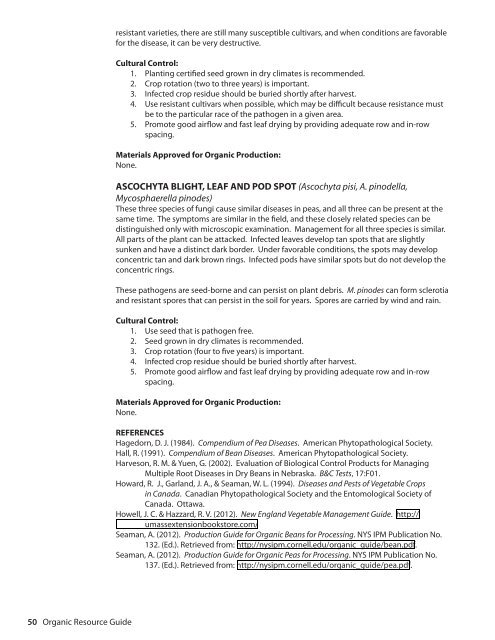Resource Guide for Organic Insect and Disease ... - Cornell University
Resource Guide for Organic Insect and Disease ... - Cornell University
Resource Guide for Organic Insect and Disease ... - Cornell University
Create successful ePaper yourself
Turn your PDF publications into a flip-book with our unique Google optimized e-Paper software.
esistant varieties, there are still many susceptible cultivars, <strong>and</strong> when conditions are favorable<br />
<strong>for</strong> the disease, it can be very destructive.<br />
Cultural Control:<br />
1. Planting certified seed grown in dry climates is recommended.<br />
2. Crop rotation (two to three years) is important.<br />
3. Infected crop residue should be buried shortly after harvest.<br />
4. Use resistant cultivars when possible, which may be difficult because resistance must<br />
be to the particular race of the pathogen in a given area.<br />
5. Promote good airflow <strong>and</strong> fast leaf drying by providing adequate row <strong>and</strong> in-row<br />
spacing.<br />
Materials Approved <strong>for</strong> <strong>Organic</strong> Production:<br />
None.<br />
ASCOCHYTA BLIGHT, LEAF AND POD SPOT (Ascochyta pisi, A. pinodella,<br />
Mycosphaerella pinodes)<br />
These three species of fungi cause similar diseases in peas, <strong>and</strong> all three can be present at the<br />
same time. The symptoms are similar in the field, <strong>and</strong> these closely related species can be<br />
distinguished only with microscopic examination. Management <strong>for</strong> all three species is similar.<br />
All parts of the plant can be attacked. Infected leaves develop tan spots that are slightly<br />
sunken <strong>and</strong> have a distinct dark border. Under favorable conditions, the spots may develop<br />
concentric tan <strong>and</strong> dark brown rings. Infected pods have similar spots but do not develop the<br />
concentric rings.<br />
These pathogens are seed-borne <strong>and</strong> can persist on plant debris. M. pinodes can <strong>for</strong>m sclerotia<br />
<strong>and</strong> resistant spores that can persist in the soil <strong>for</strong> years. Spores are carried by wind <strong>and</strong> rain.<br />
Cultural Control:<br />
1. Use seed that is pathogen free.<br />
2. Seed grown in dry climates is recommended.<br />
3. Crop rotation (four to five years) is important.<br />
4. Infected crop residue should be buried shortly after harvest.<br />
5. Promote good airflow <strong>and</strong> fast leaf drying by providing adequate row <strong>and</strong> in-row<br />
spacing.<br />
Materials Approved <strong>for</strong> <strong>Organic</strong> Production:<br />
None.<br />
REFERENCES<br />
Hagedorn, D. J. (1984). Compendium of Pea <strong>Disease</strong>s. American Phytopathological Society.<br />
Hall, R. (1991). Compendium of Bean <strong>Disease</strong>s. American Phytopathological Society.<br />
Harveson, R. M. & Yuen, G. (2002). Evaluation of Biological Control Products <strong>for</strong> Managing<br />
Multiple Root <strong>Disease</strong>s in Dry Beans in Nebraska. B&C Tests, 17:F01.<br />
Howard, R. J., Garl<strong>and</strong>, J. A., & Seaman, W. L. (1994). <strong>Disease</strong>s <strong>and</strong> Pests of Vegetable Crops<br />
in Canada. Canadian Phytopathological Society <strong>and</strong> the Entomological Society of<br />
Canada. Ottawa.<br />
Howell, J. C. & Hazzard, R. V. (2012). New Engl<strong>and</strong> Vegetable Management <strong>Guide</strong>. http://<br />
umassextensionbookstore.com/<br />
Seaman, A. (2012). Production <strong>Guide</strong> <strong>for</strong> <strong>Organic</strong> Beans <strong>for</strong> Processing. NYS IPM Publication No.<br />
132. (Ed.). Retrieved from: http://nysipm.cornell.edu/organic_guide/bean.pdf.<br />
Seaman, A. (2012). Production <strong>Guide</strong> <strong>for</strong> <strong>Organic</strong> Peas <strong>for</strong> Processing. NYS IPM Publication No.<br />
137. (Ed.). Retrieved from: http://nysipm.cornell.edu/organic_guide/pea.pdf.<br />
50 <strong>Organic</strong> <strong>Resource</strong> <strong>Guide</strong>







